#NASA InSight lander
Photo


NASA’s InSight Lander Detects Stunning Meteoroid Impact on Mars
Christmas came a little early for NASA’s InSight mission last December when the lander detected a massive quake on Mars.
Now, scientists know what caused the red planet to rumble. A meteoroid slammed into Mars 2,174 miles (3,500 kilometers) away from the lander and created a fresh impact crater on the Martian surface.
The ground literally moved beneath InSight on December 24, 2021, when the lander recorded a magnitude 4 marsquake. Before and after photos captured from above by the Mars Reconnaissance Orbiter, which has been circling Mars since 2006, spotted a new crater this past February.
When scientists connected the dots from both missions, they realized it was one of the largest meteoroid strikes on Mars since NASA began studying the red planet. Images from the orbiter’s two cameras showed the blast zone of the crater, which allowed scientists to compare it with the epicenter of the quake detected by InSight.
The space rock also revealed boulder-size ice chunks when it slammed into Mars. They were found buried closer to the warm Martian equator than any ice that has ever been detected on the planet.
#NASA InSight Lander Detects Meteoroid Impact on Mars#nasa mars reconnaissance orbiter#nasa insight lander#mars#the roman god of war#nasa#nasa photos#nasa picture of the day#space#solar system#astronomy#amazing#ice on mars
43 notes
·
View notes
Text
Title: This Is Not Goodbye
Fandom: Space/Space Vehicles
Author: ourswordsmeandeath
Rating: G
Words: 100
Summary:
The wind kicks up unexpectedly around Sol 106.
A drabble about the NASA InSight Lander.

#Mars#InSight#Mars lander#NASA#NASA InSight#JPL#space#outer space#planet#robot#Mars robot#InSight Mars Lander#Jet Propulsion Laboratory#space vehicle#Mars mission#science#NASA InSight lander#lander#NASA lander#space fic
3 notes
·
View notes
Text


Rest in Peace InSight😢
2 notes
·
View notes
Text
“I’ll be signing off here, soon.” - InSight, Dec 20th 2022
“So, Human Andrea? Why we have landed on the [Planet of the War God]?”
The human before xem, entrenched in gear and insulated materials, face unseeable through the dark transparent mineral making up what they see through, spoke, “I was wondering if someone had, well, returned something.” Xir observed the lingering periwinkle across her nape and shoulders, tinting the usual peppy green she exuded.
“What is there to return? Humanity had never inhabited the [Planet of the War God], I believe. You achieved mass FTL travel before you learnt planet terraforming.”
“Hah,” the female laughed, “We may not have inhabited [Mars] but we did send… rovers. To see what it was like. We had planned, or discussed at the least, the inhabitability of it.”
They trudged through the barren dirt, Andrea staring determinately in one direction, likely observing a tracker of some sort on their HUD. Xir curiousity eventually got the better of xem.
“What, exactly, are you looking for, Human Andrea?”
The woman huffed, amused, “Well, I’m looking for the rovers, of course.”
“But why? Surely, by now, the rovers would’ve broken down?”
“Oh, probably.” Andrea’s body language, from what they could observe, was amused. Deeply so, even. The spike of yellow-green, followed by a melancholy purple deepened from the prior periwinkle cemented the fact. Deeply amused by xir confusion yet quite sad about their topic of conversation.
“I’m looking for InSight, mostly, but Sojourner, Spirit, Perseverance, or Curiousity are fine too. Maybe i’ll find Opportunity, but… Oh! Well. My scanners are showing that all of them are still here.”
The spike of wistfulness was unexpected, an almost positive tint to her words.
“You had said you were wondering if someone have returned something, why ‘returned’?”
“I was wondering if someone remembered them.” Here, it was sadness.
Xir blinked, or at least, that’s what xey believed how Human Andrea would describe xir Sight-Reset. Xey were blinded by the [spectrum of the sky] that flowed through her green.
“You are sad, that no one seems to have remembered these inconsequential rovers, yet you are… happy? That they are here for you to find?”
A spike of irritation, quickly washed away by resignment. “We humans pack bond to anything, Scylla, they’re not inconsequential to me.”
Xey do not believe that long-[powerless][dead][lost][depleted] rovers had impact on Human Andrea’s life, short as her existence (in terms of a human) had been. Still, xey trudged forward with the young adult, silent and grave as Human Andrea walked, a [ceremony of the dead] march, for comrades lost.
If xey had a phrase to describe it… ah, what was that saying in the [Lands of the Pariahs] of their home?
‘For as long as you exist, in memory or in bone, there is neither death nor [death in memory]’
Some notes about this for clarification and other stuff below :D
Andrea means Manly, and i thought it was fitting when i searched up the name halfway through writing.
Scylla, the alien, is a synaesthetic species wihout ‘eyes’ Xey are capable of seeing emotion (although everyone’s emotions have different colours. There is no universality to it. Someone’s anger could be a deep dark blue, for example, not a plain red.)
The ‘body language’ Scylla is referring to is, in fact, the synaesthesia that ripples with Andrea’s movements and emotions.
Scylla is indeed named after a deep sea greek monster, no i do not know why, but it is a nickname, not xir actual name (andrea gave it to xem after failing to pronounce xir actual name several times)
The phrases or words in square brackets are words that are being transliterated (if i’m using that word correctly) they are essentially words that i would’ve liked to have an english word for, or thought wouldn’t have the same terminology for an alien species.
Yes, i chose to make xem use ‘planet of the war god’ because i wanted to.
‘Spectrum of the sky’ is ‘rainbow’ if that wasn’t obvious.
the four phrases/words in a row were for long-dead except meant to be a more ‘general’ term for ‘loss of existence’ where ‘loss of existence’ wouldn’t have been gramatically or thematically correct.
‘Ceremony of the dead’ is indeed ‘funeral’ and, ‘death in memory’ is for a word i wish exists. It would make my poetry so much easier.
The ‘Land of the Pariahs’ mentioned is a barren desert on Scylla’s homeland. Nomads travel it, and are known for the hundreds of stories passed down, growing generation by generation, of pictures and pieces of lives once lived.
Scylla thinks the rovers had no impact on Andrea because they were a good few decades ago, actually. The newer ones were later retrieved, but Andrea had heard about these ones from grandparents etc. and fell in love with them.
This was written upon my knowledge of InSight’s loss of power, because of the dust build up on it’s solar panels. I pay my respects to the lander, and wish whatever tiny sliver of existence it had a peaceful future exploration of things that we do not know.
Finally, thank you for reading this! I hope you have a nice day/night and may we one day give our rovers and drones and landers their respectful resting places.
#randomartmaker rambles#randomartmaker writing#humans are space orcs#humans are space oddities#humans are space australians#humans are space fae#pack bonding#aliens#humans and aliens#nasa mars#mars#short story#small story#my writing#mars insight lander#wrote this at 10pm lolol#sorry to any injustices i do#i am tired
171 notes
·
View notes
Text

I'm not crying I just have a branch in my eye
186 notes
·
View notes
Link
Welcome to another exciting episode of Astronomy Daily with your host, Anna. In today's episode, we've got a stellar lineup of fascinating space news straight from the cosmos. From a historic lunar flyby by the European Space Agency's JUICE mission to unexpected discoveries about Mars, courtesy of NASA's InSight lander. We've got it all. We'll also dive into the groundbreaking Polaris Dawn mission, which promises to feature the first-ever commercial spacewalk. And if that weren't enough, we'll wrap things up with a fun twist: zero gravity snacks from Doritos that are making their way into space. Buckle up, because this journey through the universe is going to be out of this world.
- **ESA's JUICE Mission: A Historic Lunar Flyby**: The European Space Agency's Jupiter Icy Moons Explorer (JUICE) is performing an unprecedented double gravity assist maneuver by swinging by both the Moon and Earth. This historic event aims to slingshot JUICE toward its ultimate destination, Jupiter and its intriguing moons Ganymede, Callisto, and Europa. The Moon's gravity served as a break, enabling JUICE to slow down in its trajectory relative to the Sun, effectively saving the spacecraft about six months of travel time. Photographs from the lunar encounter were taken using JUICE's onboard monitoring cameras, capturing remarkable images shared in real-time with the public via a live webcast.
- **Unexpected Discoveries on Mars**: NASA's Mars InSight lander, though no longer active, continues to provide invaluable data. A new study revealed that Mars gets bombarded by space rocks far more frequently than previously estimated. This insight comes from a combination of seismic data and orbital imagery, suggesting a pressing need to update our current models of Martian geological activity and surface evolution. Notably, two of the newly discovered craters are the largest ever detected on Mars, each roughly the size of a football field. This finding has far-reaching implications for our understanding of planetary surfaces across the solar system.
- **Polaris Dawn Mission: The First Commercial Spacewalk**: The Polaris Dawn mission team, led by billionaire entrepreneur Jared Isaacman, is ready to embark on a groundbreaking journey. This mission raises the stakes in commercial space exploration by aiming to perform the first-ever commercial spacewalk. The crew, including retired US Air Force pilot Scott "Kidd" Poteet and SpaceX engineers Anna Menon and Sarah Gillis, will attempt to break Earth orbit altitude records and conduct approximately 40 experiments. Additionally, the mission aims to pioneer high-speed internet access in space using Starlink connectivity.
- **Zero Gravity Snacks: Doritos in Space**: Doritos is launching a new limited edition flavor called Cool Ranch Zero Gravity, designed specifically for space travel. These specially formulated chips feature an oil-based coating to prevent crumbs from floating in microgravity environments. The Polaris Dawn mission will see its crew become the first people to eat Doritos in space. Doritos has partnered with the Polaris Dawn crew to raise awareness and funds for St. Jude Children's Research Hospital, contributing a $500,000 donation and offering fans the chance to win mission-themed memorabilia.
For more Astronomy Daily, including our continually updating newsfeed, visit our website at astronomydaily.io. Follow us on social media at AstroDailyPod on Facebook, X, YouTubeMusic, and TikTok. We love engaging with our community, so be sure to drop us a message or comment on your favorite platform.
For more Space and Astronomy News Podcasts, visit our HQ at www.bitesz.com.
Become a supporter of this podcast: https://www.spreaker.com/podcast/astronomy-daily-the-podcast--5648921/support.
Keep looking up, and I'll see you tomorrow!
#agency#astronomy#commercial#daily#dawn#discoveries#doritos#european#flyby#insight#juice#lander#lunar#mars#mission#nasa#polaris#space#spacewalk#zero
2 notes
·
View notes
Photo


40 notes
·
View notes
Photo

Saying 'Farewell' to InSight Mars Lander | NASA
On Dec.18, 2022, InSight did not respond to communications from Earth. As expected, the lander’s power has been declining for months, and it’s assumed InSight may have reached its end of operations. NASA will declare the mission over when InSight misses two consecutive communication sessions with the spacecraft orbiting Mars, part of the Mars Relay Network – but only if the cause of the missed communication is the lander itself. After that, NASA’s Deep Space Network will listen for a time, just in case.
InSight launched from Vandenberg Air Force Base in California on May 5, 2018. After a six-month cruise, InSight landed on Mars on Nov. 26, 2018, and immediately began surface operations at Elysium Planitia, but science data collection didn't start fully until about 10 weeks after landing. That's because InSight's science goals and instruments are very different from other Mars landers or rovers. In some ways, InSight's science activities were designed to be more like a marathon than a sprint. Over the past four years, the lander data has yielded details about Mars’ interior layers, its liquid core, the surprisingly variable remnants beneath the surface of its mostly extinct magnetic field, weather on this part of Mars, and lots of quake activity.
Learn more about InSight, the first mission to explore Mars' deep interior.
15 notes
·
View notes
Text

THE INSIGHT LANDER IS RUNNING OUT OF POWER

10 notes
·
View notes
Text
Not me getting emotional about a signoff message about a robot on Mars

6 notes
·
View notes
Text
And once again I'm crying for a little robot I never knew. 😢
NASA's Insight lander has gone to sleep. Goodbye little friend! Thank you for your hard work.
His last words...
My power’s really low, so this may be the last image I can send. Don’t worry about me though: my time here has been both productive and serene. If I can keep talking to my mission team, I will – but I’ll be signing off here soon. Thanks for staying with me. pic.twitter.com/wkYKww15kQ
— NASA InSight (@NASAInSight) December 19, 2022
2 notes
·
View notes
Text
Goodnight, InSight. We will see you when you awake again, from the great beyond. (x)
1 note
·
View note
Text
NASA Retires InSight Mars Lander Mission After Years of Science
NASA’s InSight mission has ended after more than four years of collecting unique science on Mars.
from NASA https://ift.tt/Z4ixeMl
0 notes
Photo

Saying 'Farewell' to InSight Mars Lander via NASA The lander's journey of discovery into the interior structure and composition of Mars has come to a close. https://ift.tt/rlZXViB
0 notes
Text

9 Out-of-This-World Moments for Space Communications & Navigation in 2023
How do astronauts and spacecraft communicate with Earth?
By using relay satellites and giant antennas around the globe! These tools are crucial to NASA’s space communications networks: the Near Space Network and the Deep Space Network, which bring back science and exploration data every day.
It’s been a great year for our space communications and navigation community, who work to maintain the networks and enhance NASA’s capabilities. Keep scrolling to learn more about our top nine moments.

The SpaceX Falcon 9 rocket carrying the Dragon spacecraft lifts off from Launch Complex 39A at NASA's Kennedy Space Center in Florida on Thursday, Nov. 9, 2023, on the company's 29th commercial resupply services mission for the agency to the International Space Station. Liftoff was at 8:28 p.m. EST.
1. In November, we launched a laser communications payload, known as ILLUMA-T, to the International Space Station. Now, ILLUMA-T and the Laser Communications Relay Demonstration (LCRD) are exchanging data and officially complete NASA’s first two-way, end-to-end laser relay system. Laser communications can send more data at once than traditional radio wave systems – think upgrading from dial-up to fiber optic internet. ILLUMA-T and LCRD are chatting at 1.2 gigabits per second (Gbps). At that rate, you could download an average movie in under a minute.
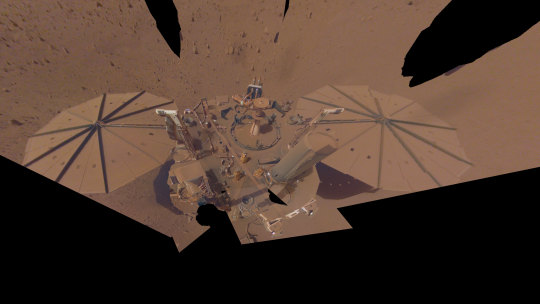
NASA’s InSight lander captured this selfie on Mars on April 24, 2022, the 1,211th Martian day, or sol, of the mission.
2. Data analyzed in 2023 from NASA’s retired InSight Mars lander provided new details about how fast the Red Planet rotates and how much it wobbles. Scientists leveraged InSight’s advanced radio technology, upgrades to the Deep Space Network, and radio signals to determine that Mars’ spin rate is increasing, while making the most precise measurements ever of Mars’ rotation.
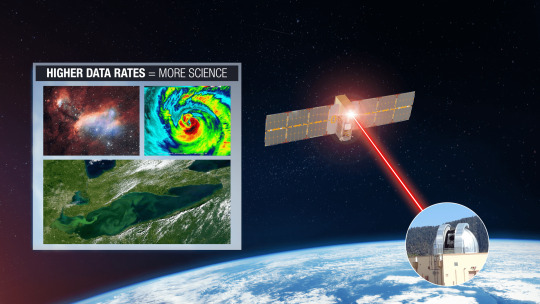
TBIRD is demonstrating a direct-to-Earth laser communications link from low Earth orbit to a ground station on Earth.
3. We set a new high record! The TeraByte InfraRed Delivery (TBIRD) payload – also demonstrating laser communications like ILLUMA-T and LCRD – downlinked 4.8 terabytes of data at 200 Gbps in a single 5-minute pass. This is the highest data rate ever achieved by laser communications technology. To put it in perspective a single terabyte is the equivalent of about 500 hours of high-definition video.
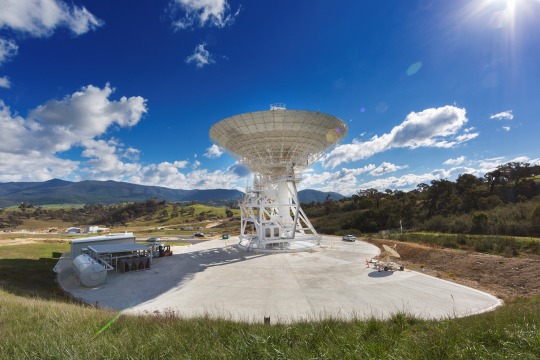
A 34-meter (112-foot) wide antenna at Canberra Deep Space Communications Complex near Canberra, Australia.
4. This year we celebrated the Deep Space Network’s 60th anniversary. This international array of antennas located at three complexes in California, Spain, and Australia allow us to communicate with spacecraft at the Moon and beyond. Learn more about the Deep Space Network’s legacy and future advancements.
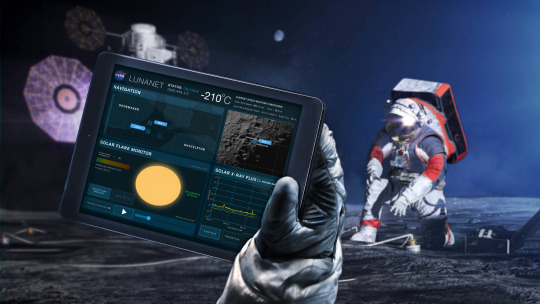
An illustration of the LunaNet architecture. LunaNet will bring internet-like services to the Moon.
5. We are bringing humans to the Moon with Artemis missions. During expeditions, astronauts exploring the surface are going to need internet-like capabilities to talk to mission control, understand their routes, and ensure overall safety. The space comm and nav group is working with international partners and commercial companies to develop LunaNet, and in 2023, the team released Draft LunaNet Specification Version 5, furthering development.
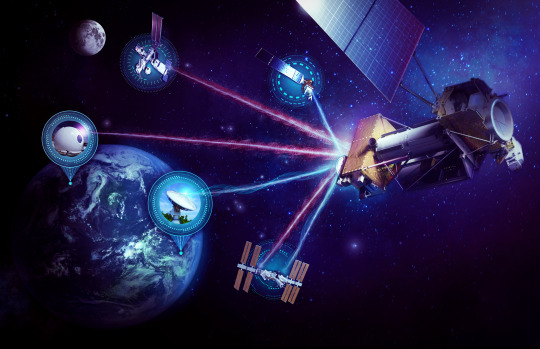
The High-Rate Delay Tolerant Networking node launched to the International Space Station in November and will act as a high-speed path for data.
6. In addition to laser communications, ILLUMA-T on the International Space Station is also demonstrating high-rate delay/disruption tolerant networking (HDTN). The networking node is showcasing a high-speed data path and a store-and-forward technique. HDTN ensures data reaches its final destination and isn’t lost on its path due to a disruption or delay, which are frequent in the space environment.

The Communications Services Project (CSP) partners with commercial industry to provide networking options for future spaceflight missions.
7. The space comm and nav team is embracing the growing aerospace industry by partnering with commercial companies to provide multiple networking options for science and exploration missions. Throughout 2023, our commercialization groups engaged with over 110 companies through events, one-on-one meetings, forums, conferences, and more. Over the next decade, NASA plans to transition near-Earth services from government assets to commercial infrastructure.

Middle and high school students solve a coding experiment during NASA's Office of STEM Engagement App Development Challenge.
8. Every year, NASA’s Office of STEM Engagement sponsors the App Development Challenge, wherein middle and high school students must solve a coding challenge. This year, student groups coded an application to visualize the Moon’s South Pole region and display information for navigating the Moon’s surface. Our space communications and navigation experts judged and interviewed students about their projects and the top teams visited NASA’s Johnson Space Center in Houston!
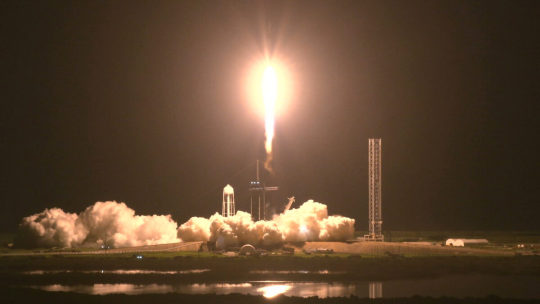
A SpaceX Falcon 9 rocket soars upward after liftoff at the pad at 3:27 a.m. EDT on Saturday, Aug. 26, from Kennedy Space Center’s Launch Complex 39A in Florida carrying NASA’s SpaceX Crew-7 crew members to the International Space Station. Aboard SpaceX’s Dragon spacecraft are NASA astronaut Jasmin Moghbeli, ESA (European Space Agency) astronaut Andreas Mogensen, JAXA (Japan Aerospace Exploration Agency) astronaut Satoshi Furukawa, and Roscosmos cosmonaut Konstantin Borisov.
9. The Near Space Network supported 19 launches in 2023! Launches included Commercial Crew flights to the International Space Station, science mission launches like XRISM and the SuperBIT balloon, and many more. Once in orbit, these satellites use Near Space Network antennas and relays to send their critical data to Earth. In 2023, the Near Space Network provided over 10 million minutes of communications support to missions in space.
Here’s to another year connecting Earth and space.
Make sure to follow us on Tumblr for your regular dose of space!
1K notes
·
View notes
